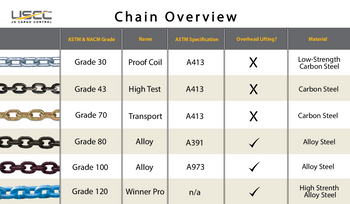


When selecting the right chain for your application, understanding the different grades available is crucial. Chains are graded based on their strength, durability, and suitability for specific tasks. These grades represent the strength and durability of the material - the higher the number, the stronger the chain. We turned one of our most popular blog posts on the differences between chain grades into a simple chart for quick and easy comparison. We also added information on the Grade 30 and Grade 43 chains. (While we don't sell these grades on our website, you can always call in to order them.) Read on to learn more about the differences between chain grades offered through US Cargo Control and their uses.
Each chain grade offers unique benefits catered to specific applications. Selecting the appropriate chain grade depends on the requirements of these applications. Understanding the differences helps you select the right one for the job, ensuring safety, efficiency, and longevity. Below are the different chain grades offered through US Cargo Control:

Organizations like ASTM (American Society of Testing & Materials), ASME (American Society of Mechanical Engineers), and OSHA (Occupational Safety & Health Administration) have released safety standards and regulations for various materials and grades of a chain.
Essentially, it's a formal way of recognizing and documenting that not all chain is created equally and therefore, it should not all be used for the same applications.
What do A413, A391, and A973 all mean? Those are simply how the ASTM categorizes and references their specification standards. Each specification outlines the different manufacturing and testing requirements as well as the appropriate performance standards, grades, and applications.
Chain grades are a standard method for showing the ultimate breaking strength (tensile strength) of a chain. Grades help determine what sort of applications are appropriate for a given chain.
Chain grades are determined by calculating newtons per square millimeter, using the formula “N/mm 2 ”. Where "mm" is the area of the two cross-sections of a single chain link, and "N" is newtons. A newton is approximately 0.224805 lbs.
So, to determine a chain grade, manufacturers must find the ultimate breaking strength. Then, divide that number by .224805 to determine the ultimate breaking strength in newtons.
Next, take that number and divide it by the total area of two cross-sections of a single link. That number is the chain grade.
You could reverse this formula to determine the ultimate breaking strength if all you know is the chain grade.
Note: chain grades advertised by manufacturers are one-tenth of the actual mathematical grades. So grade 80 is really 800, and grade 120 is 1,200.
Working load limit (WLL) of a chain is another designated safety measure. WLL is a weight significantly less than the weight that would cause a chain to fail (tensile strength). WLL = MBL / SF. Where MBL is the minimum breaking load and SF is the safety factor.
A safety factor is the ratio between allowable stress and actual stress. In other words, it's the ratio between the chain strength and the expected maximum stress. In lifting and rigging applications, factors such as gravity and the additional force caused by angles must be considered.
Always adhere to the WLL to ensure a chain does not break or wear quicker than it should.